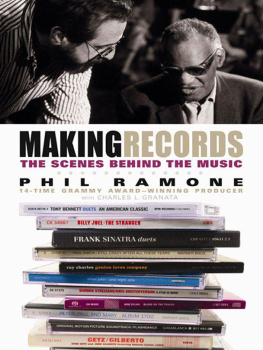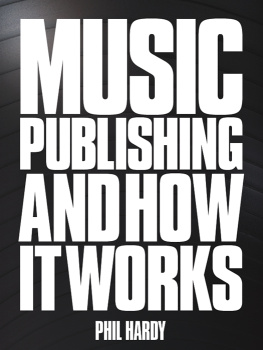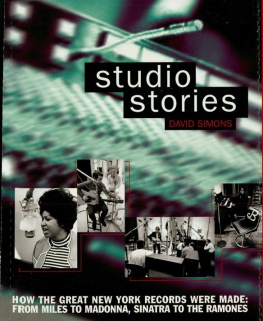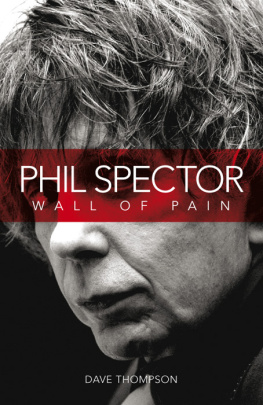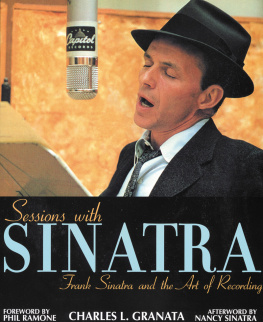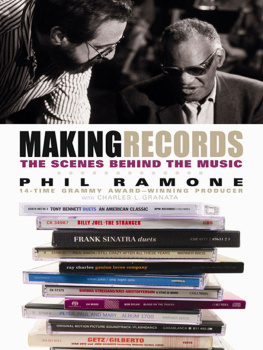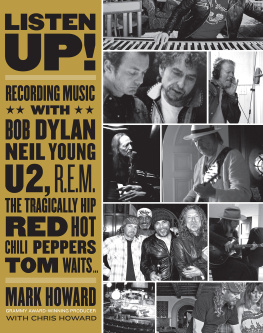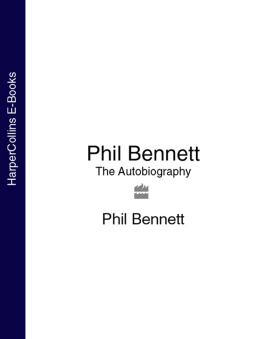Phil Ramone & Charles L. Granata

Dedicated to Min, for mentoring Doreen and me.
The mentoring continues with Karen, Matt,
Simon, BJ, Ann, Maxwell, Andi, Rick, Kelly, Seth,
Elizabeth, Joe, Suzie, Doug, Melissa, Kim,
Neal, Stacy, and Julie.

I N MEMORY OF D AVID S MITH
19512006
TRACK LISTING

Receiving the Grammy for Genius Loves Company from Bonnie Raitt, 2003 Courtesy of Michael Caulfield/WireImage

Courtesy of Larry Busaca
The greatest interaction in the world is the creativity involved in making music.
I wish everyone could experience the birth of a record the way I do, from the time a songwriter hits on a brilliant idea through the long hours spent getting it down on tape.
What makes for a great record? A fantastic song, convincing performance, and superb sound.
Theres a craft to making records, and behind every recording lie dozens of details that are invisible to someone listening on the radio, CD player, or iPod.
Wherever I go, Im amazed by the curiosity that both casual and serious music lovers express for the marginalia surrounding the records they love.
Who wrote the song, and why did the artist choose to perform it? Why was it done in a particular style? When, where, and how was it recorded? What decisions went into building the mix? What was happening in the world, the artists life, and the studio on the day the record was made, and how did those things affect the performance?
The answers to these questions are what I live for, and Im grateful that people are fascinated by the magic behind what we as engineers and producers do. And so, this book is about making records: the way we made them when I started in the late 1950s, the way we make them now, and everything in between.
Like mixing a record, condensing the decades of ones working life into the finite pages of a book necessitates many reductive decisions.
While it touches on numerous areas of my life and work, this volume is not an autobiography or technical manual, nor does it pretend to be a definitive study of any one topic related to record production. Instead, Ive painted a broad picture, using personal anecdotes and vignettes to help illustrate the complex road traveled by songwriters, artists, engineers, and producers who contribute to the art of making records.
As an engineer and producer, Ive strived to give singers and musicians the confidence to develop their ideas, find their best performance, and use the latest technology to share it with the world. Im pleased to offer a glimpse behind the scenes, with hopes that the next time you hear one of your favorite records youll be able to say, Aha! Thats how they did it.
Phil Ramone
New York City
April 2007

With Frank Sinatra, A&R Recording Studios NYC, 1967 Phil Ramone Collection
June 28, 1993.
Capitol Records Studio A, Hollywood and Vine Streets, Los Angeles.
The short walk from the main studio to the control room takes what seems to be an eternity. My heart thumps in my chest.
As I enter the booth, its thick door seals behind me with a sturdy whoosh . Trying to hide my disappointment, I look at the crew.
Thats it, gentlemen. Hes gone.
At the end of any other night, these words might bring a collective sigh of relief, a funny comment, or a round of applauseall tension breakers meant to relax. Tonight they come at the start, and their implication is ominous.
Frank Sinatra, uncharacteristically full of self-doubt, has left the first session for his eagerly anticipated Duets album, and we have nothing to show for it.
While the notion of undertaking such a project is a gamble, Im confident that pairing Sinatra with a variety of legendary artists will make for an attention-grabbing record. Theres timelessness to Sinatras music, and though his voice might be showing signs of age, he can still wring every nuance from a lyric.
I feel more prepared for this album than for any other of my career; Ive worked with Frank before, and understand his musical shorthand.
Whether youre a musician or a producer, you always know where you stand with Sinatra. Since some of the younger guys arent familiar with the singers recording jargon or my cryptic signals, I warn them to listen carefully, and to watch my hands.
I realize that when the musical sparks start to fly we might have only one shot at getting it on tape, so Ive assembled a top-notch team to work alongside of me: arranger-conductor Patrick Williams, engineer Al Schmitt, coproducer Hank Cattaneo (Sinatras longtime production manager), and Don Rubin, head of Capitols A&R department.
Patrick has lovingly reworked many of Sinatras classic arrangements, the sassy swing and the tender ballad charts written by Nelson Riddle, Billy May, Don Costa, Billy Byers, and Quincy Jones. As I watch Patrick greet Frank for the first time, I recall what he said after the original scores arrived from the Sinatra library.
Phil, he explained, I opened the package and put them on the desk, and right on top was a chart marked, Ive Got You Under My Skinarranged by Nelson Riddle. Nelsons copyist, Vern Yocum, had scrupulously handwritten every part. When I saw that I started to cry. It was one song after another, right there on my deskall of these great Sinatra songs that had been such an important part of my life.
Sinatras music represents the apotheosis of American popular music. The original chartssome yellowed and dog-earedare the same ones that sat on the musicians stands in this very room on the balmy nights when Frank first recorded his classic interpretations of the songs nearly forty years ago. For a musician or arranger, the chance to make a tactile connection such as thisto touch and reinterpret such well-respected musicis a humbling experience.
For a project such as Duets, a first-class engineer is a must and at my side is Al Schmitt. In addition to having recorded some of the best-sounding records of the past thirty years, Al is the last person to fold under pressure.
Ditto Hank Cattaneo, who has toured with Frank as his personal soundman for almost twenty years. Other than Quincy Jones, few people understand the complexities of a Sinatra performanceor the mans temperamentbetter than Hank does.
Don Rubin, a veteran EMI artist & repertoire executive and close associate of Capitol Records chairman Charles Koppelman, has tended to the dozens of business issues that accompany such an ambitious project.
Desiring to make Franks return to Capitol Records special, weve lavished lots of attention on the details.
In a small passageway between Studios A and B (an area that is occasionally used as a vocal or drum booth), weve created a lounge with a couch, table, and bar stocked with Franks favorite snacks and beverages. Knowing that he might want to warm up privately with pianist Bill Miller, weve placed a small piano in there, too.

